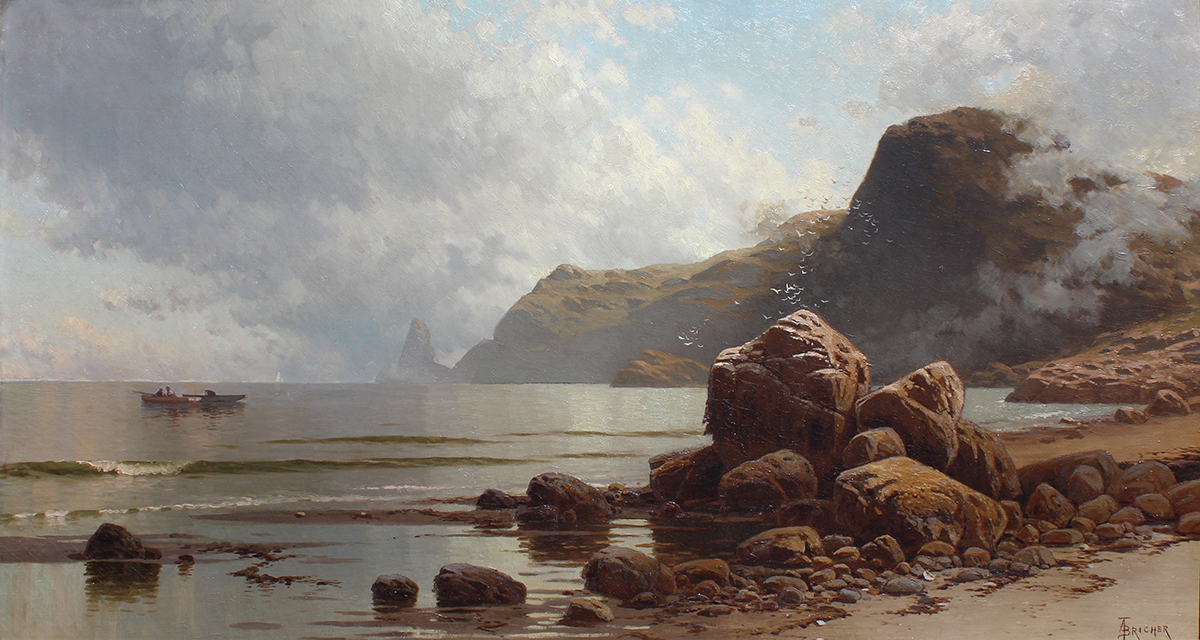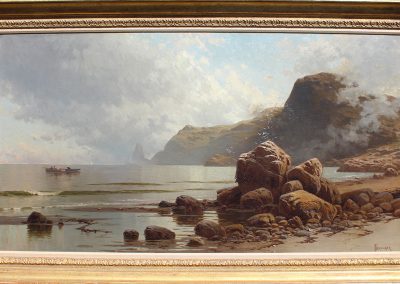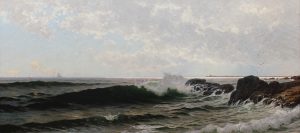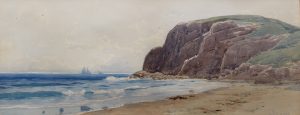Alfred T. Bricher (1837-1908)
Marine and landscape painter Alfred Thompson Bricher is known principally for his oil and watercolor paintings of the New England coastline. He was born in Portsmouth, New Hampshire in 1837, and in 1840 relocated with his family to Newburyport, Massachusetts. Bricher moved to Boston in 1851 to seek employment, and worked as a clerk at a mercantile house while painting part-time. As an artist, Bricher was largely self-taught, but may have studied in Newburyport and at the Lowell Institute in Boston. In 1858 he began painting full-time and established a studio in Newburyport. That year he made the first of many sketching trips–to Mt. Desert Island in Maine with Charles Temple Dix and William S. Haseltine–which, throughout his career, would take him to: Long Island, along the Hudson River, to Lake George and into the Catskill and Adirondack Mountains of New York; to New Jersey; throughout Massachusetts; to Conway, the White Mountains, and elsewhere in New Hampshire; and along the coast of Maine. In 1859 Bricher opened a studio in Boston, though he continued to visit and work in and around Newburyport as well. In June of 1866 he made a sketching trip along the Mississippi River, and into Iowa, Wisconsin and Minnesota. During the 1860s, Bricher collaborated with L. Prang and Company to produce chromolithographs of his paintings. One of the last great Luminist artists, Bricher was described by fellow painter William S. Barrett as “not a studio painter,” but a “lover of true nature.” In 1868, Bricher and his bride, Susan Wildes of Boston moved to New York City. In 1871 the artist began sketching along the coast of Rhode Island. Around 1874 he made his first trip to Grand Manan Island in New Brunswick, Canada. Shortly after this the artist probably traveled to England, for in 1876-77 he began exhibiting English subjects. In 1890 he built a home in New Dorp, Staten Island, New York where he lived until his death in 1908. Bricher was a member of the American Watercolor Society, an Associate Member of the National Academy, and member of the Boston Art Club and the Art Union. His work was exhibited at: the Boston Athenaeum; the 1864 Sanitary Fair; the American Society of Painters in Water Colors; the National Academy of Design; the Brooklyn Art Association; the Boston Art Club; the Inter-State Industrial Exposition of Chicago; the Cincinnati Industrial Exposition; the Art Institute of Chicago; the 1876 Philadelphia Centennial Exposition; Gill’s Art Galleries, Springfield; the 1878 Paris Exposition Universelle; the Salmagundi Club; the 1884 Southern Exposition, Louisville; the Pennsylvania Academy of the Fine Arts; the 1893 World’s Columbian Exposition, Chicago; and the Art Club of Philadelphia. Today, Bricher’s work can be found in many private and public collections throughout the United States and Europe, including: the Metropolitan Museum of Art, New York City; Museum of Fine Arts, Boston; the Fine Arts Museums, San Francisco; the Butler Institute of American Art, Ohio; the Smithsonian American Art Museum, Washington DC; and the Thyssen-Bornemisza Museum, Madrid.
Low Tide, South Head, Grand Manan Island, Maine
by Alfred T. Bricher (1837-1908)
| Medium | Oil |
| Medium Detail | Oil on canvas |
| Dimensions | 26 x 48 inches; Framed: 34 x 56 inches |
| Signed Location | Lower right |
Printable version
View additional works by Alfred T. Bricher
This artwork is no longer in our inventory
Contact Us About This Piece




